 Image search results - "odori" Image search results - "odori" |

My video of 2023 Koenji Awa Odori. 第64回高円寺阿波おどり
|
|

My video of 2018 Koenji Awa Odori 第62回高円寺阿波おどり
|
|

My video of 2017 Koenji Awa Odori (56 troupes) 第61回高円寺阿波おどり
|
|

My video of 2016 Koenji Awa Odori (56 troupes) 第60回高円寺阿波おどり 56連の総集編
|
|

My video of Koenji Awa Odori 2015 第59回高円寺阿波おどり 40連の総集編
|
|

My video of Koenji Awa Odori 2013 Part 1/3 第57回 東京高円寺阿波おどり 総集編
|
|

My video of Koenji Awa Odori 2013 Part 2/3 第57回 東京高円寺阿波おどり 総集編
|
|

My video of Koenji Awa Odori 2013 Part 3/3 第57回 東京高円寺阿波おどり 総集編
|
|

My video of Koenji Awa Odori 2011 Part 1/2 高円寺阿波おどり
|
|

My video of Koenji Awa Odori 2011 Part 2/2 高円寺阿波おどり
|
|

My video of Koenji Awa Odori 2009 Part 1/3 - Kokesaku 苔作
|
|

My video of Koenji Awa Odori 2009 Part 2/3 - Kikusui-ren 菊水会菊水連
|
|

My video of Koenji Awa Odori 2009 Part 3/3 - Asuka-ren 飛鳥連
|
|
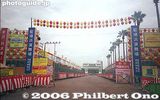
One of Japan's grandest festivals, the Tokushima Awa Odori is a summer dance performed in central Tokushima city. Numerous dance troupes called "ren" appear in a long parade along the city's main streets for four evenings in mid-Aug. About 2 million people see it during the four days it is held. It is like a bon dance to greet the souls of the deceased returning to visit. There are other Awa Odori festivals in Japan, but the one in Tokushima is the original and largest one. "Awa" is the former feudal name of Tokushima. Photo: Entrance to one of the spectator areas called "embujo" (admission charged). 藍場浜演舞場
|
|
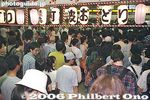
Crowd at JR Koenji Station on Awa Odori night.The Koenji Awa Odori is basically a parade of dancers. Many groups of dancers from various parts of Japan participate in the parade that follows the main shopping streets near Koenji Station on the Japan Railways Chuo Line in Tokyo.
|
|

April 8, 2006 at Ushigome-Tansu Kumin Hall in Kagurazaka, TokyoStarting at 4 pm, this was the third and last show of the day and all 400 seats were sold out.
The performance had two parts separated by a 20-min. intermission. Each part had several different dances.
|
|

PR poster for the Kamogawa Odori geisha dance held during May 1-24 in Pontocho.
|
|

Kanagawa Prefecture's largest Awa Odori is held annually during the last weekend in July in this city of Yamato. Preview event near Yamato Station.
|
|
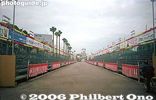
Spectator seats. Admission is 1,000 to 2,000 yen.
|
|

Each dance troupe starts with a lantern bearer showing the name of the troupe.The dance is quite simple. While bobbing up and down, the dancer holds her hands above the head and shakes the fingers. This hand gesture indicates that the person has gone crazy. It is therefore nicknamed the "fool's dance." The dance is held on the last weekend in August.
|
|

Part 1 - Edo Scenes (江戸風情): 1. Fuji Murasaki (Purple Wisteria) 藤むらさきDancers: 小奴、千佳、由良子、舞子
|
|

Pontocho Kaburenjo theater, venue for Kamogawa Odori.
|
|
|

Crowds already line Tokushima's main street soon to be closed to traffic.
|
|
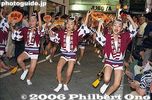
The troupe can consist of children (as young as age 2 or 3), women, and men.The Awa Odori originated 400 years ago in Tokushima Prefecture (in Shikoku) where it is one of Japan's most famous festivals. Although it is not as large as the one in Tokushima, the Koenji Awa Odori in Tokyo has become a major summer festival in Tokyo.
|
|
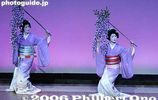
1. Fuji Murasaki (Purple Wisteria)
|
|

Pontocho is a narrow alley and known as a geisha district.
|
|

Pre-festival event held in the afternoon, Yamato Awa Odori
|
|

These photos were taken in Aug. 1999.
|
|

The Koenji Awa Odori has become a major summer festival in Tokyo. It had a humble beginning in 1957 when it was originally called the Koenji Baka Odori. "Baka" means fool.
|
|

1. Fuji Murasaki (Purple Wisteria)
|
|

Dance program for 2005.
|
|
|
|
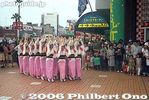
Pre-festival warm-up performance.
|
|

1. Fuji Murasaki (Purple Wisteria)
|
|

Barrels of sake next to the theater.
|
|

Yamato Station
|
|

One trademark of the dancers is the crescent-shaped straw hats.
|
|
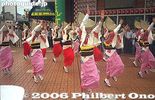
This was in front of a dept. store near Tokushima Station.
|
|
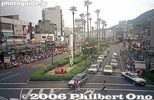
Shinmachi-bashi road in front of Tokushima Station 新町橋通りIt was Awa Odori time.
|
|

1. Fuji Murasaki (Purple Wisteria)
|
|
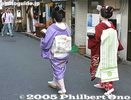
A geisha/geiko and maiko head to the theater to see the Kamogawa Odori. Notice the different obi sash on the back.A maiko is an apprentice geisha. Her obi sah on the back is long, as well as her sleeves.
|
|

Balloons, souvenirs and trinkets sold near the train station.
|
|

The men look more like the "fools."
|
|
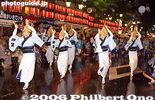
The parade route centers on JR Koenji Station. There are wide and narrow portions of the route.If it rains, they may stop the festival early.
|
|

Sculpture of Awa Odori dancers on mailbox
|
|
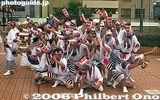
They performed in the afternoon.
|
|
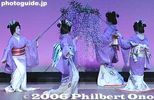
1. Fuji Murasaki (Purple Wisteria) by Kagurazaka geisha
|
|

Pontocho Kaburenjo theater
|
|
|

Sculpture of Awa Odori dancers
|
|

Tokushima's Awa Odori originated in 1587 to mark the completion of Izan Castle in Tokushima (formerly called Awa Province). The castle lord allowed the people to celebrate and they danced the night away.
|
|

1. Fuji Murasaki (Purple Wisteria)
|
|

Geiko and maiko in front of Pontocho Kaburenjo theater
|
|

Main drag and shopping arcade called Yamato Chuo-dori大和中央通り
|
|

It is most crowded along the large avenues. The crowd is several rows deep. Those in the front are expected to sit down.
|
|

Rear view of a dancer
|
|

Sculpture of Awa Odori dancer
|
|

1. Fuji Murasaki (Purple Wisteria)
|
|

Entrance to Pontocho Kaburenjo theater. You can buy tickets for the day's performance.
|
|

Spectators wait for the parade to begin.
|
|

The dancers hop on one leg.So what is Tokushima's Awa Odori doing in Koenji, Tokyo? It was first organized by a youth group of Koenji's retail merchants in 1957. They wanted to hold an event to attract more shoppers to the area. Neighboring town Asagaya had already started the Tanabata Festival in 1954. The Tanabata Matsuri, of course, is from up north in Sendai, Miyagi Pref. So the Koenji folks decided to transplant a southern festival to Koenji. That was the Awa Odori.
|
|

Tokushima Awa Odori dancer
|
|
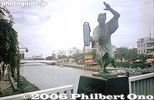
Sculpture of Awa Odori dancer
|
|

1. Fuji Murasaki (Purple Wisteria)
|
|

Inside the theater, waiting for the start of the 168th Kamogawa Odori (in 2005) to start.
|
|

The festival/parade starts before dark.
|
|

The first Koenji Awa Odori in 1957 had only 57 dancers and about 2,000 spectators. Iroha-ren いろは連There are now about 30 to 40 Awa Odori parades held in Tokyo alone, usually in shopping areas. The one in Koenji is the largest in Tokyo.
|
|

Condensed mirror of Awa Odori dancerAibahama Park in the distance.
|
|
|

1. Fuji Murasaki (Purple Wisteria)
|
|

Part 1 Monogusa Soshi: Taro's Shack. Lazy Taro does nothing but compose poems all day in his shack. 物ぐさ草紙 太郎の小屋The first half is a musical play with a storyline.
|
|
|
|

These days, they have 10,000 dancers from 70 dance groups and over 1 million spectators. Also see the video at YouTube.いろは連
|
|
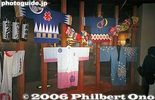
Awa Odori Kaikan museumHappi coats worn by Awa Odori dance troupes.
|
|

Free Awa odori lessons.
|
|

1. Fuji Murasaki (Purple Wisteria)Dancer's name is Maiko 舞子
|
|

Taro's Shack
|
|
|

Each dance troupe is called a "ren." This is the Suiko-ren. 吹鼓連
|
|
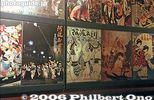
Awa Odori Kaikan museumAwa Odori publicity posters.
|
|

Lining up for the non-reserved spectator seats.
|
|

1. Fuji Murasaki (Purple Wisteria)
|
|
|
|
|

The dance troupe typically has subgroups of children, women, men, and musicians. Suiko-ren 吹鼓連吹鼓連
|
|

The Awa Odori begins before dark.
|
|

1. Fuji Murasaki (Purple Wisteria)
|
|

Magistrate's House
|
|
|

The dancers wear a light kimono and half-moon straw hats.
|
|
|

Edo Scenes: 2. Sumidagawa (Sumida River)Solo dancer: 眞由美 (Mayumi)
|
|
|
|

Musicians always bring up the rear of the dance troupe. Taiko drums, flutes, and shamisen. The Awa Odori has a distinct rhythm and beat. It really makes you want to get up and dance.
|
|
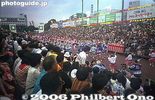
All spectator seats were taken.
|
|

2. Sumidagawa (Sumida River)
|
|
|
|

The dancers also let out a yell as they dance. Hana-no-ki-ren 花の木連
|
|
|

2. Sumidagawa (Sumida River)
|
|
|
|
|

Other dancers might also wear a simpler outfit of short pants and happi coat. Swinging around a fan is also common.花の木連
|
|
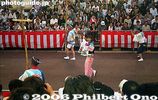
Actress Fujita Tomoko heads one dance troupe.
|
|

Edo Scenes: 3. Edo no Nigiwai (Liveliness of Edo) 江戸の賑わいDancers: 竜也、英子、万り
|
|

Taro overhears the Lord's daughter trying to compose a poem.
|
|
|

These pictures show over 40 dance troupes which I photographed in 2004 and 2005. Budo-ren 富道連富道連
|
|
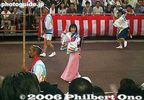
The festival usually features a celebrity or two. This is actress Fujita Tomoko at the Tokushima Awa Odori.
|
|
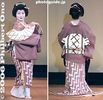
3. Edo no Nigiwai (Liveliness of Edo)
|
|
|
|

Budo-ren 富道連富道連
|
|
|
|
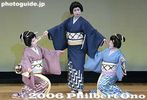
3. Edo no Nigiwai (Liveliness of Edo)
|
|

Taro helps her compose her poem.
|
|
|

The dance troupes come from in and out of town. A few from Tokushima as well as Kanagawa, Chiba, Shizuoka, and other prefectures. Edokko-ren 江戸っ子連
|
|
|

3. Edo no Nigiwai (Liveliness of Edo)After this dance was a 20-min. intermission.
|
|

Taro has a scuffle with the daughter and breaks her koto instrument.
|
|

Mime act depicting a kite
|
|

Tokushima and Tokyo have the most number of Awa Odori troupes with 40 to 50 each.Edokko-ren 江戸っ子連
|
|
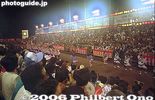
My compact camera lens had a flare/halation problem.
|
|

Part 2 - 浴曲三味線草: 1. Kagurazakari 神楽ざかり
|
|

Mother scolds the daughter for the scuffle with Taro.
|
|

A fool's dance.
|
|

Edokko-ren 江戸っ子連
|
|
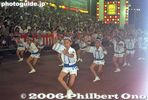
Finally found a seat closer to the road.
|
|
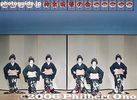
1. Kagurazakari 神楽ざかり
|
|
|

End of the parade route.
|
|

Kokesaku-ren 苔作連
|
|
|
|

1. Kagurazakari 神楽ざかり
|
|
|
|

Kokesaku-ren 苔作連
|
|
|
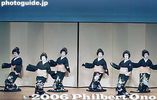
1. Kagurazakari 神楽ざかり
|
|
|
|
|

Kimagu-ren きまぐ連
|
|
|

Singers and musicians
|
|

It turns out that Taro was a grandson of the Emperor.
|
|

Yamato Awa OdoriHeld in late July, Kanagawa Pref.
|
|

Kimagu-ren きまぐ連
|
|
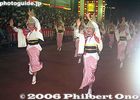
Really hard taking pictures with a small compact camera with no telephoto zoom.
|
|

1. Kagurazakari 神楽ざかり
|
|
|

Chidori-ren troupeちどり連
|
|

美遊ひよこ連
|
|

2. Hitozato ひと里
|
|

Tokushima Awa Odori dancer
|
|

2. Hitozato ひと里
|
|

Taro gets to marry the lord's daughter.
|
|

ちどり連
|
|

美遊ひよこ連
|
|

Tokushima Awa Odori is also called the "Fool's Dance"
|
|
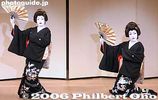
3. 梅にも春 Ume ni mo HaruDancers: 千丸、史織
|
|
|
|

Yamato Awa Odori
|
|

美遊ひよこ連
|
|
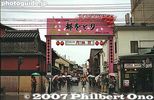
Entrance to the road leading to the Cherry Dance theater (Gion Kobu Kaburenjo) in the Gion district. The sign says "Miyako Odori."
|
|
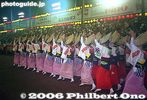
Tokushima Awa Odori
|
|

3. 梅にも春 Ume nimo Haru
|
|
|
|

美遊ひよこ連
|
|

Flute player
|
|

More signposts reading "Miyako Odori." "Miyako" means capital (Kyoto was once Japan's capital city), and "Odori" means dance.
|
|

3. 梅にも春 Ume nimo HaruOffering a drink of sake.
|
|

End of Part 1 with a happy ending.
|
|
|

Bikkuri-ren びっくり連
|
|
|

"Miyako Odori" sign post. Performed for over a century, the dance makes April a very special time in Kyoto. It helps to hone the dance and musical skills of the geiko and maiko who diligently practice for this annual dance.
|
|
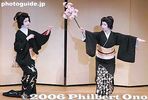
4. Sakura Kazashite 桜かざしてDancers: 舞子、万り (Maiko and Mari)
|
|

Part 2: Passing of Spring in Kyoto, "Nanohanaya" (Rape blossoms) 菜の花やPart 2 of the program consists of dance numbers.
|
|
|

Midori-ren 美踊連
|
|
|

4. Sakura Kazashite 桜かざしてDancer 舞子 (Maiko)
|
|

"Nanohanaya" (Rape blossoms) 菜の花や
|
|
|
|

Midori-ren 美踊連
|
|

"Miyako Odori" poster in English.
|
|

Tokushima Awa Odori dancer
|
|

"Miyako Odori" poster and paper lantern.
|
|

5. Otsu-e 大津絵眞由美 (Mayumi)
|
|

"Nanohanaya"
|
|

Woman drummer
|
|

Midori-ren 美踊連
|
|
|
|

5. Otsu-e 大津絵眞由美
|
|

"Nanohanaya"
|
|
|

F.I.A.-ren えふあいえい連
|
|
|

PR posters and paper lanterns for the Miyako Odori are everywhere.
|
|

6. Hahha Kudoki ハッハくどき
|
|

"Nanohanaya" (Rape blossoms) 菜の花や
|
|
|

F.I.A.-ren えふあいえい連
|
|
|

Ichiriki, a famous geisha tea house.
|
|
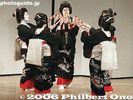
6. Hahha Kudoki ハッハくどき
|
|

"Nanohanaya" (Rape blossoms). They dance like they were melting into the sea of flowers. 菜の花や
|
|
|

Sometimes you see a gaijin participant. F.I.A.-ren えふあいえい連
|
|

End of the course
|
|

Maiko and geisha can often be seen in Gion.
|
|
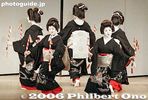
6. Hahha Kudoki ハッハくどき
|
|

"Nanohanaya" (Rape blossoms) 菜の花や
|
|

Chidori-ren was my favorite of all.ちどり連
|
|

Mitaka-ren みたか連
|
|
|

Gate to Kobu Kaburenjo Theater. Four shows daily in April, lasting about 1 hour (too short). Ticket prices range from 1900 yen to 4300 yen.
|
|
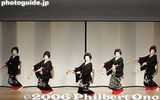
6. Hahha Kudoki ハッハくどき
|
|

"Irises" are in full bloom. 菖蒲
|
|
|

Mitaka-ren みたか連
|
|
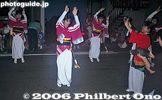
In front of my hotel after the festival ended.This group continued dancing late into the night.
|
|

Gate to Kobu Kaburenjo Theater. You can make ticket reservations by phone, or go directly to the theater ticket office and buy tickets.
|
|

6. Hahha Kudoki ハッハくどき
|
|

"Irises" 菖蒲
|
|
|

Mitaka-ren みたか連
|
|
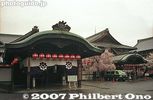
Gion Kobu Kaburenjo Theater. Ticket office is on the right. Best to buy tickets at least a few days in advance.
|
|

6. Hahha Kudoki ハッハくどき
|
|

"Irises" 菖蒲 She rises from beneath the stage.
|
|

Their dance moves were outstanding.
|
|

Kikusui-ren 菊水会菊水連
|
|

7. Sawagi さわぎThe finale where all the geisha appear on stage.
|
|
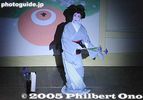
"Irises" She holds an iris flower. She just took a bath with iris leaves. 菖蒲
|
|

They were in great physical condition.
|
|

Kikusui-ren 菊水会菊水連
|
|
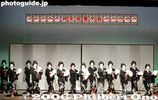
7. Sawagi さわぎ
|
|

"Irises" 菖蒲
|
|

The men in Chidori-ren.
|
|

Kikusui-ren 菊水会菊水連
|
|

7. Sawagi さわぎ
|
|

Comical play called "Kyogen Furyu" 狂言風流
|
|
|
|

Kikusui-ren 菊水会菊水連
|
|

7. Sawagi さわぎ
|
|

"Kyogen Furyu" 狂言風流
|
|
| 1922 files on 8 page(s) |
1 |
 |
 |
 |
 |
|